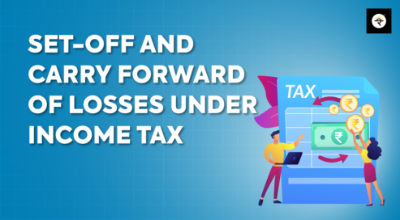Managing your finances effectively is crucial, especially when it comes to taxes. One aspect that can significantly impact your tax liability is how you handle losses. The Income Tax Act provides provisions for setting off and carrying forward losses, ensuring that taxpayers can optimize their tax liability over multiple years. In this blog, we’ll explore these concepts in detail.
What is Set Off of Losses?
Set off of losses refers to adjusting the loss incurred in one source of income against the profit earned from another source within the same financial year. The Income Tax Act categorizes income into different heads, such as:
- Income from Salary
- Income from House Property
- Profits and Gains from Business or Profession
- Capital Gains
- Income from Other Sources
Income tax allows losses to be set off against income from these heads under certain conditions.
Inter-head and Intra-head Set Off
Intra-head Set Off: Losses from one source of income can be set off against income from another source under the same head. For example, a loss from one business can be set off against profit from another business.
Inter-head Set Off: If after intra-head set off, there is still some loss remaining, it can be set off against income from another head. However, there are restrictions. For instance, losses from capital gains can only be set off against capital gains.
Rules for Set Off
Income from House Property: Loss from house property can be set off against any other head of income.
Business Loss: Non-speculative business loss can be set off against any income except salary income.
Speculative Business Loss: Can only be set off against speculative business income.
Capital Loss: Long-term capital loss can be set off only against long-term capital gains. Short-term capital loss can be set off against both short-term and long-term capital gains.
Loss from Other Sources: Loss from other sources can generally be set off against income from other sources, except losses from activities such as lotteries, cryptos or racehorses, which have specific restrictions.

What is Carry Forward of Losses?
If losses cannot be fully set off in the current year, they can be carried forward to subsequent years, subject to certain conditions.
Rules for Carry Forward
- Filing a Return: To carry forward losses, the taxpayer must file their income tax return within the due date.
- House Property Loss: Can be carried forward for 8 years and set off against income from house property.
- Business Loss: Non-speculative business loss can be carried forward for 8 years and set off against business income.
- Speculative Business Loss: Can be carried forward for 4 years and set off against speculative business income.
- Capital Loss: Long-term capital loss can be carried forward for 8 years to be set off against long-term capital gains. Short-term capital loss can also be carried forward for 8 years and set off against any capital gains.
- Loss from Other Sources: Losses from other sources (like owning and maintaining racehorses) can be carried forward for 4 years and set off only against income from such activities.

Example of Set Off and Carry Forward
Example: Mr. A's Capital Gains from Equity Shares (Long Term) for Year 1
Capital Gain: Mr. A has a long-term capital gain of ₹100,000.
Tax Calculation: Since the gain is within the ₹100,000 exemption limit under Section 112A, Mr. A pays zero tax.
Strategy: By strategically selling core holdings up to ₹100,000, Mr. A can ensure that his long-term capital gains are tax-free.
Example Scenario for Year 2:
Capital Gains and Losses:
Long-Term Gain: ₹150,000
Short-Term Loss: ₹50,000
Net Taxable Gain:
After offsetting the short-term loss, the net taxable capital gain is ₹100,000.
Tax Calculation: Since the net gain is ₹100,000, it falls under the exemption limit of Section 112A, resulting in zero tax for the year.
Investment Strategy: After booking the losses, Mr. A can reinvest the capital into fixed income-bearing securities to generate additional returns. This approach not only ensures tax efficiency but also helps in earning returns on the reinvested capital.
Time Value of Money:
Earning Returns: By booking the losses and reinvesting the capital into fixed income securities, Mr. A earns returns on the same money rather than holding onto a loss-making investment.
Generating Alpha: This strategy generates alpha over the capital by making returns on the reinvested funds, thereby enhancing the overall portfolio performance.
Summary:
By utilizing Section 112A effectively, Mr. A can plan and save tax on gains up to ₹100,000 each year. This strategy involves:
Booking Gains: Selling core holdings up to the ₹100,000 exemption limit.
Offsetting Losses: Using short-term losses to reduce the taxable gain.
Reinvesting: Parking the capital in fixed income-bearing securities to earn returns and optimize the portfolio performance.
In this way, Mr. A can make use of tax exemptions and the time value of money to enhance returns and maintain a tax-efficient investment strategy.
Conclusion
Understanding the provisions for setting off and carrying forward losses can significantly reduce your tax burden as well as give you more cash in hand to invest and earn returns. It’s essential to keep accurate records and file your tax returns timely to take full advantage of these benefits. Consulting with a tax professional can also help in effectively managing your tax liabilities and planning for the future.


